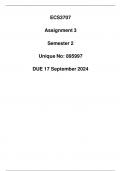Exam (elaborations)
ECS3707 Assignment 3 (895997) Due 17 September 2024
QUESTION 1 [40 MARKS] Critically assess the merits of using economic metrics such as Gross Domestic Product (GDP) per capita versus broader multidimensional measures like the Human Development Index (HDI) or Multidimensional Poverty Index (MPI) for understanding development progress. 1.1 Comp...
[Show more]



